Nursing Assignment - Dementia Care
VerifiedAdded on 2023/06/08
|12
|3435
|414
AI Summary
This nursing assignment discusses the assessment performed on an elderly patient suffering from dementia and strategies to empower the patient and support independence. The care plan includes exercise routines, memory aids, fall hazard assessment, and education. The patient showed improvement in his condition and was more independent in his movement.
Contribute Materials
Your contribution can guide someone’s learning journey. Share your
documents today.
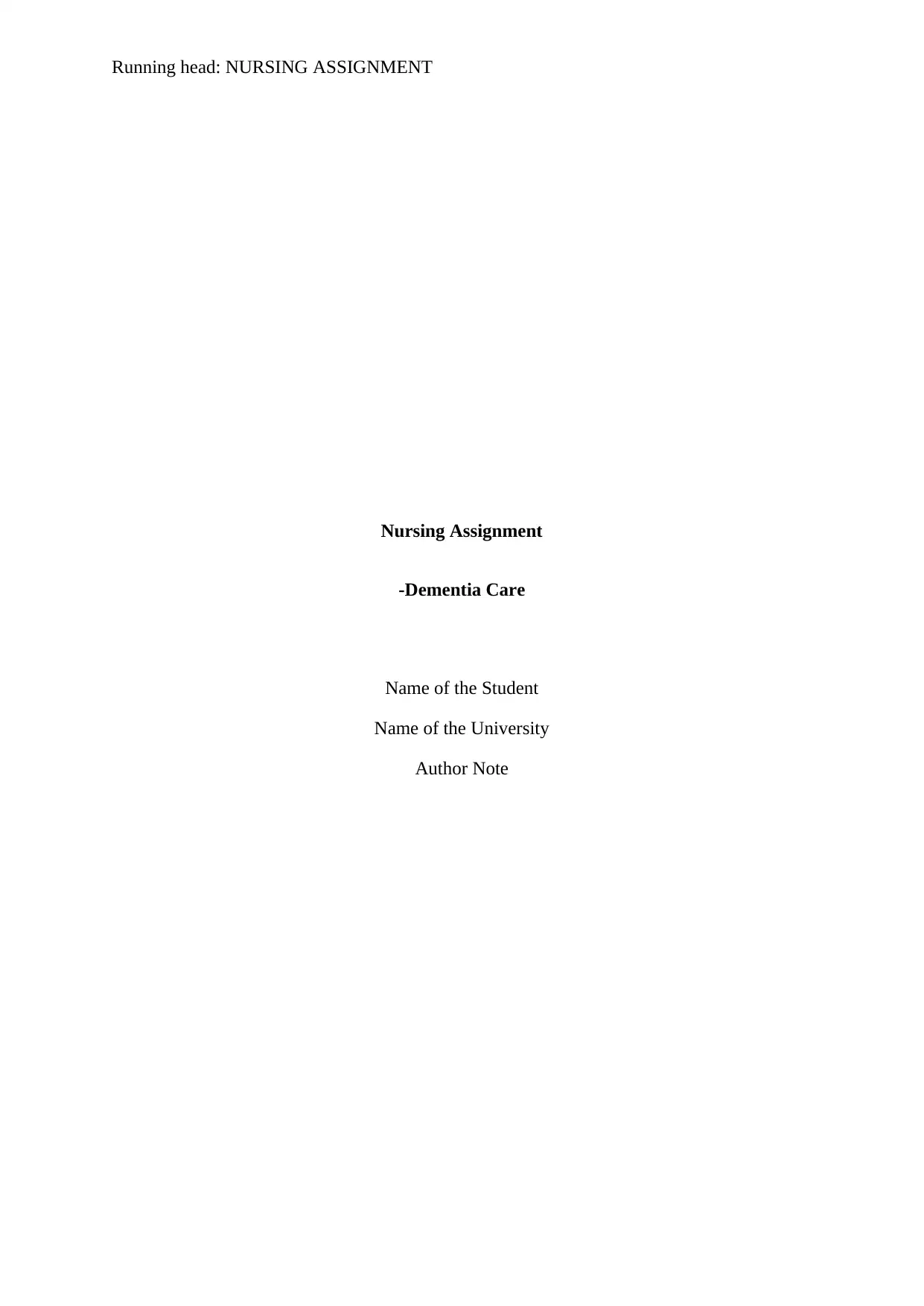
Running head: NURSING ASSIGNMENT
Nursing Assignment
-Dementia Care
Name of the Student
Name of the University
Author Note
Nursing Assignment
-Dementia Care
Name of the Student
Name of the University
Author Note
Secure Best Marks with AI Grader
Need help grading? Try our AI Grader for instant feedback on your assignments.

1NURSING ASSIGNMENT
Introduction:
The following case study is of an elderly patient, Mr Nyugen, aged 85 years who is
suffering from dementia and was presented to the emergency room for a fall related injury to
his head. He received a 1 cm cut to his forehead and was bleeding. The doctor recommended
a CT scan for the patient to check any signs of internal injury after cleaning and suturing the
wound. The aim of this report is to discuss the assessment performed on the patient
(including risk assessment), strategies that can help to empower the patient and support
independence, the psychological effects of the interventions identified, followed by a
reflection on the learning acquired from the case study.
Outline of the case scenario:
Using the clinical reasoning cycle, I was able to outline the patient condition to
identify the care priorities for the patient:
Patient Situation:
The patient is 85 years old, who was presented to the ED with a head injury that was
caused due to a fall and hitting with furniture. The patient has problems walking and uses a
walking stick. However due to his dementia, he keeps forgetting to use the walker, and also
forgets his medications. He currently lives alone, and his daughter lives next door with her
husband and family, and the patient is a widower. He also has a history of PTSD while he
was in the Army. He also is a heavy smoker and smoker about three packs of cigarettes every
week.
Important Cues/Information and its relation to patient condition:
The patient has advancing dementia that is causing problems with his memory as well
as has reduced his mobility (Kosse et al., 2015). The diagnosis of dementia can also be the
Introduction:
The following case study is of an elderly patient, Mr Nyugen, aged 85 years who is
suffering from dementia and was presented to the emergency room for a fall related injury to
his head. He received a 1 cm cut to his forehead and was bleeding. The doctor recommended
a CT scan for the patient to check any signs of internal injury after cleaning and suturing the
wound. The aim of this report is to discuss the assessment performed on the patient
(including risk assessment), strategies that can help to empower the patient and support
independence, the psychological effects of the interventions identified, followed by a
reflection on the learning acquired from the case study.
Outline of the case scenario:
Using the clinical reasoning cycle, I was able to outline the patient condition to
identify the care priorities for the patient:
Patient Situation:
The patient is 85 years old, who was presented to the ED with a head injury that was
caused due to a fall and hitting with furniture. The patient has problems walking and uses a
walking stick. However due to his dementia, he keeps forgetting to use the walker, and also
forgets his medications. He currently lives alone, and his daughter lives next door with her
husband and family, and the patient is a widower. He also has a history of PTSD while he
was in the Army. He also is a heavy smoker and smoker about three packs of cigarettes every
week.
Important Cues/Information and its relation to patient condition:
The patient has advancing dementia that is causing problems with his memory as well
as has reduced his mobility (Kosse et al., 2015). The diagnosis of dementia can also be the
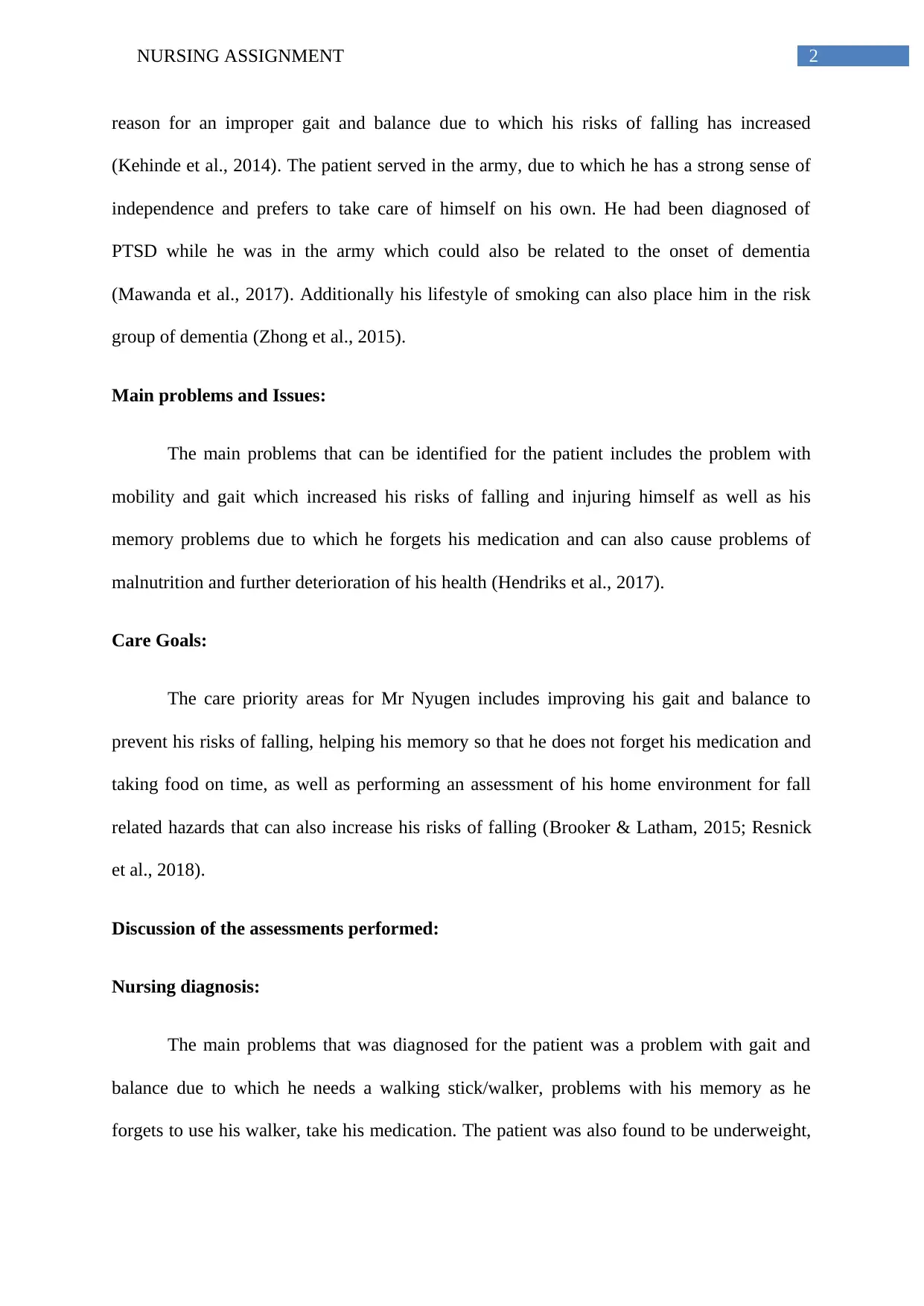
2NURSING ASSIGNMENT
reason for an improper gait and balance due to which his risks of falling has increased
(Kehinde et al., 2014). The patient served in the army, due to which he has a strong sense of
independence and prefers to take care of himself on his own. He had been diagnosed of
PTSD while he was in the army which could also be related to the onset of dementia
(Mawanda et al., 2017). Additionally his lifestyle of smoking can also place him in the risk
group of dementia (Zhong et al., 2015).
Main problems and Issues:
The main problems that can be identified for the patient includes the problem with
mobility and gait which increased his risks of falling and injuring himself as well as his
memory problems due to which he forgets his medication and can also cause problems of
malnutrition and further deterioration of his health (Hendriks et al., 2017).
Care Goals:
The care priority areas for Mr Nyugen includes improving his gait and balance to
prevent his risks of falling, helping his memory so that he does not forget his medication and
taking food on time, as well as performing an assessment of his home environment for fall
related hazards that can also increase his risks of falling (Brooker & Latham, 2015; Resnick
et al., 2018).
Discussion of the assessments performed:
Nursing diagnosis:
The main problems that was diagnosed for the patient was a problem with gait and
balance due to which he needs a walking stick/walker, problems with his memory as he
forgets to use his walker, take his medication. The patient was also found to be underweight,
reason for an improper gait and balance due to which his risks of falling has increased
(Kehinde et al., 2014). The patient served in the army, due to which he has a strong sense of
independence and prefers to take care of himself on his own. He had been diagnosed of
PTSD while he was in the army which could also be related to the onset of dementia
(Mawanda et al., 2017). Additionally his lifestyle of smoking can also place him in the risk
group of dementia (Zhong et al., 2015).
Main problems and Issues:
The main problems that can be identified for the patient includes the problem with
mobility and gait which increased his risks of falling and injuring himself as well as his
memory problems due to which he forgets his medication and can also cause problems of
malnutrition and further deterioration of his health (Hendriks et al., 2017).
Care Goals:
The care priority areas for Mr Nyugen includes improving his gait and balance to
prevent his risks of falling, helping his memory so that he does not forget his medication and
taking food on time, as well as performing an assessment of his home environment for fall
related hazards that can also increase his risks of falling (Brooker & Latham, 2015; Resnick
et al., 2018).
Discussion of the assessments performed:
Nursing diagnosis:
The main problems that was diagnosed for the patient was a problem with gait and
balance due to which he needs a walking stick/walker, problems with his memory as he
forgets to use his walker, take his medication. The patient was also found to be underweight,
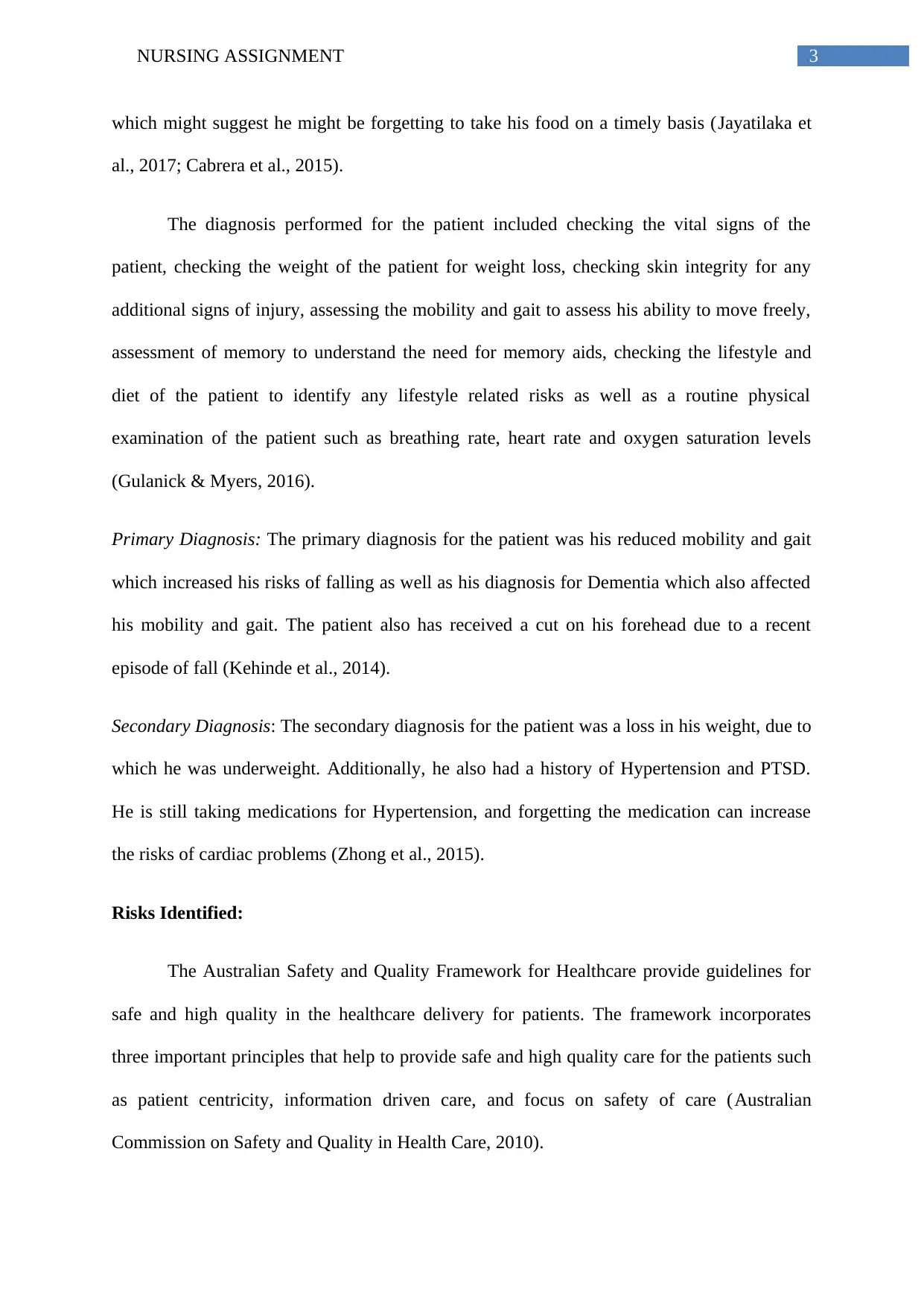
3NURSING ASSIGNMENT
which might suggest he might be forgetting to take his food on a timely basis (Jayatilaka et
al., 2017; Cabrera et al., 2015).
The diagnosis performed for the patient included checking the vital signs of the
patient, checking the weight of the patient for weight loss, checking skin integrity for any
additional signs of injury, assessing the mobility and gait to assess his ability to move freely,
assessment of memory to understand the need for memory aids, checking the lifestyle and
diet of the patient to identify any lifestyle related risks as well as a routine physical
examination of the patient such as breathing rate, heart rate and oxygen saturation levels
(Gulanick & Myers, 2016).
Primary Diagnosis: The primary diagnosis for the patient was his reduced mobility and gait
which increased his risks of falling as well as his diagnosis for Dementia which also affected
his mobility and gait. The patient also has received a cut on his forehead due to a recent
episode of fall (Kehinde et al., 2014).
Secondary Diagnosis: The secondary diagnosis for the patient was a loss in his weight, due to
which he was underweight. Additionally, he also had a history of Hypertension and PTSD.
He is still taking medications for Hypertension, and forgetting the medication can increase
the risks of cardiac problems (Zhong et al., 2015).
Risks Identified:
The Australian Safety and Quality Framework for Healthcare provide guidelines for
safe and high quality in the healthcare delivery for patients. The framework incorporates
three important principles that help to provide safe and high quality care for the patients such
as patient centricity, information driven care, and focus on safety of care (Australian
Commission on Safety and Quality in Health Care, 2010).
which might suggest he might be forgetting to take his food on a timely basis (Jayatilaka et
al., 2017; Cabrera et al., 2015).
The diagnosis performed for the patient included checking the vital signs of the
patient, checking the weight of the patient for weight loss, checking skin integrity for any
additional signs of injury, assessing the mobility and gait to assess his ability to move freely,
assessment of memory to understand the need for memory aids, checking the lifestyle and
diet of the patient to identify any lifestyle related risks as well as a routine physical
examination of the patient such as breathing rate, heart rate and oxygen saturation levels
(Gulanick & Myers, 2016).
Primary Diagnosis: The primary diagnosis for the patient was his reduced mobility and gait
which increased his risks of falling as well as his diagnosis for Dementia which also affected
his mobility and gait. The patient also has received a cut on his forehead due to a recent
episode of fall (Kehinde et al., 2014).
Secondary Diagnosis: The secondary diagnosis for the patient was a loss in his weight, due to
which he was underweight. Additionally, he also had a history of Hypertension and PTSD.
He is still taking medications for Hypertension, and forgetting the medication can increase
the risks of cardiac problems (Zhong et al., 2015).
Risks Identified:
The Australian Safety and Quality Framework for Healthcare provide guidelines for
safe and high quality in the healthcare delivery for patients. The framework incorporates
three important principles that help to provide safe and high quality care for the patients such
as patient centricity, information driven care, and focus on safety of care (Australian
Commission on Safety and Quality in Health Care, 2010).
Secure Best Marks with AI Grader
Need help grading? Try our AI Grader for instant feedback on your assignments.
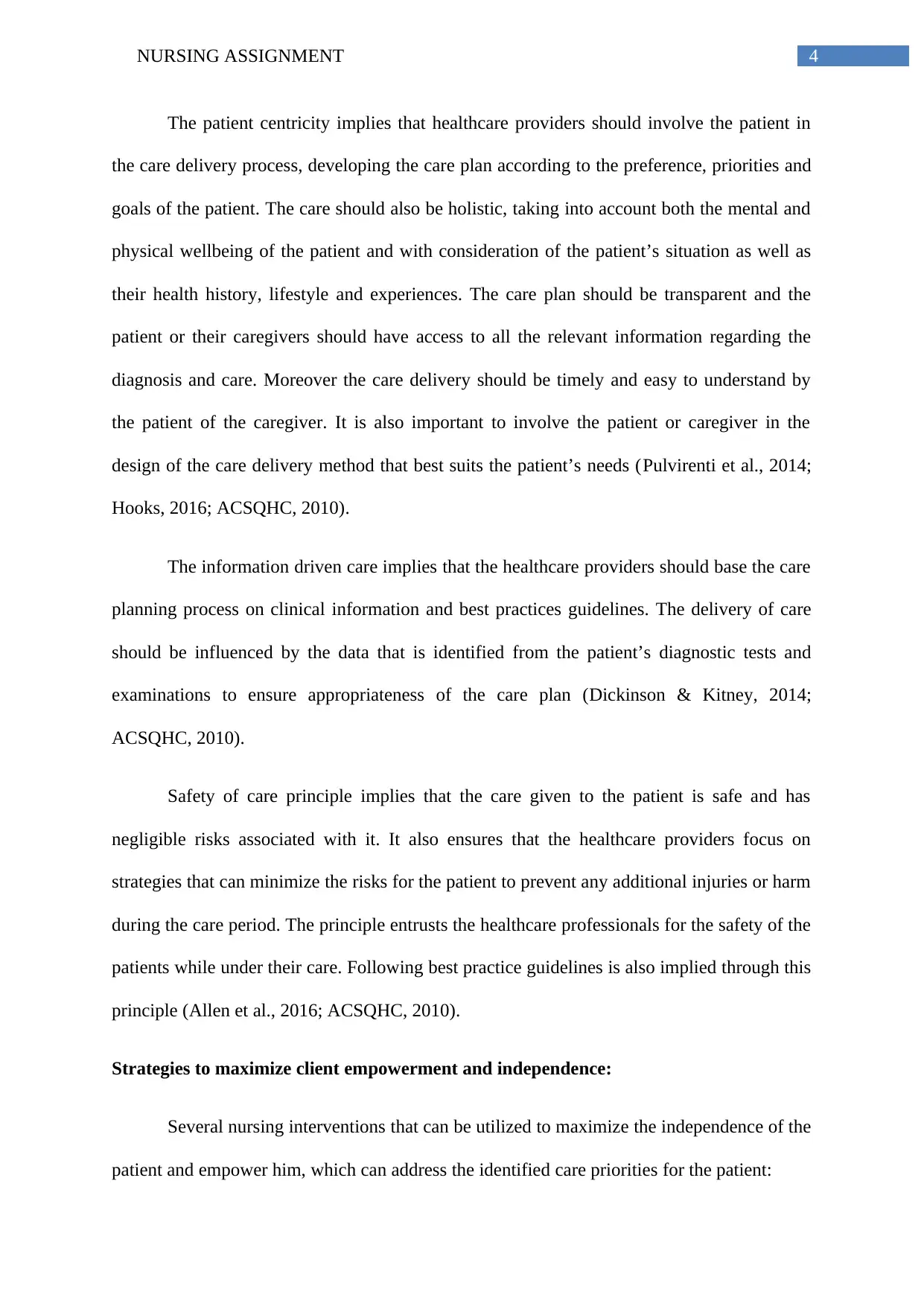
4NURSING ASSIGNMENT
The patient centricity implies that healthcare providers should involve the patient in
the care delivery process, developing the care plan according to the preference, priorities and
goals of the patient. The care should also be holistic, taking into account both the mental and
physical wellbeing of the patient and with consideration of the patient’s situation as well as
their health history, lifestyle and experiences. The care plan should be transparent and the
patient or their caregivers should have access to all the relevant information regarding the
diagnosis and care. Moreover the care delivery should be timely and easy to understand by
the patient of the caregiver. It is also important to involve the patient or caregiver in the
design of the care delivery method that best suits the patient’s needs (Pulvirenti et al., 2014;
Hooks, 2016; ACSQHC, 2010).
The information driven care implies that the healthcare providers should base the care
planning process on clinical information and best practices guidelines. The delivery of care
should be influenced by the data that is identified from the patient’s diagnostic tests and
examinations to ensure appropriateness of the care plan (Dickinson & Kitney, 2014;
ACSQHC, 2010).
Safety of care principle implies that the care given to the patient is safe and has
negligible risks associated with it. It also ensures that the healthcare providers focus on
strategies that can minimize the risks for the patient to prevent any additional injuries or harm
during the care period. The principle entrusts the healthcare professionals for the safety of the
patients while under their care. Following best practice guidelines is also implied through this
principle (Allen et al., 2016; ACSQHC, 2010).
Strategies to maximize client empowerment and independence:
Several nursing interventions that can be utilized to maximize the independence of the
patient and empower him, which can address the identified care priorities for the patient:
The patient centricity implies that healthcare providers should involve the patient in
the care delivery process, developing the care plan according to the preference, priorities and
goals of the patient. The care should also be holistic, taking into account both the mental and
physical wellbeing of the patient and with consideration of the patient’s situation as well as
their health history, lifestyle and experiences. The care plan should be transparent and the
patient or their caregivers should have access to all the relevant information regarding the
diagnosis and care. Moreover the care delivery should be timely and easy to understand by
the patient of the caregiver. It is also important to involve the patient or caregiver in the
design of the care delivery method that best suits the patient’s needs (Pulvirenti et al., 2014;
Hooks, 2016; ACSQHC, 2010).
The information driven care implies that the healthcare providers should base the care
planning process on clinical information and best practices guidelines. The delivery of care
should be influenced by the data that is identified from the patient’s diagnostic tests and
examinations to ensure appropriateness of the care plan (Dickinson & Kitney, 2014;
ACSQHC, 2010).
Safety of care principle implies that the care given to the patient is safe and has
negligible risks associated with it. It also ensures that the healthcare providers focus on
strategies that can minimize the risks for the patient to prevent any additional injuries or harm
during the care period. The principle entrusts the healthcare professionals for the safety of the
patients while under their care. Following best practice guidelines is also implied through this
principle (Allen et al., 2016; ACSQHC, 2010).
Strategies to maximize client empowerment and independence:
Several nursing interventions that can be utilized to maximize the independence of the
patient and empower him, which can address the identified care priorities for the patient:
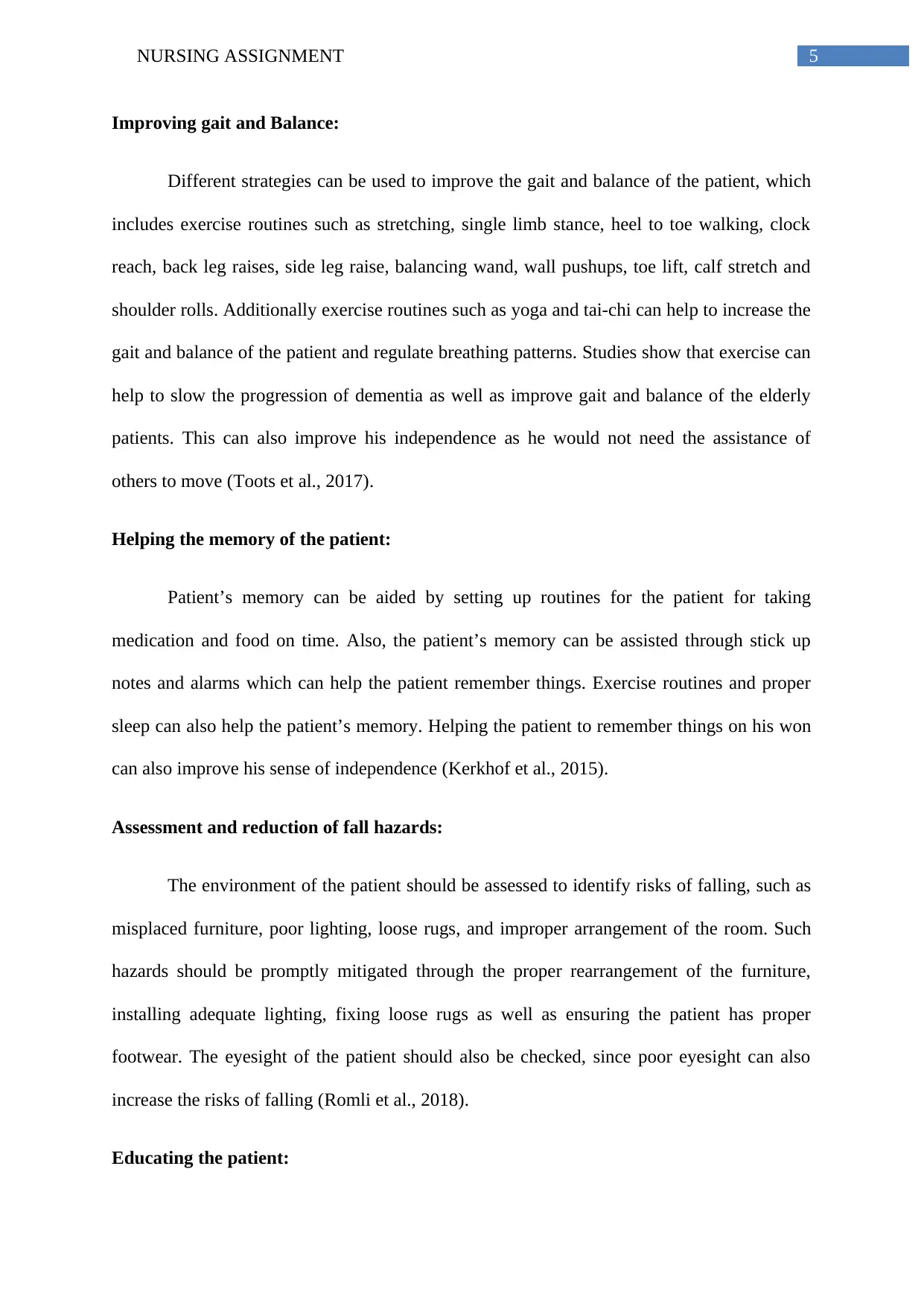
5NURSING ASSIGNMENT
Improving gait and Balance:
Different strategies can be used to improve the gait and balance of the patient, which
includes exercise routines such as stretching, single limb stance, heel to toe walking, clock
reach, back leg raises, side leg raise, balancing wand, wall pushups, toe lift, calf stretch and
shoulder rolls. Additionally exercise routines such as yoga and tai-chi can help to increase the
gait and balance of the patient and regulate breathing patterns. Studies show that exercise can
help to slow the progression of dementia as well as improve gait and balance of the elderly
patients. This can also improve his independence as he would not need the assistance of
others to move (Toots et al., 2017).
Helping the memory of the patient:
Patient’s memory can be aided by setting up routines for the patient for taking
medication and food on time. Also, the patient’s memory can be assisted through stick up
notes and alarms which can help the patient remember things. Exercise routines and proper
sleep can also help the patient’s memory. Helping the patient to remember things on his won
can also improve his sense of independence (Kerkhof et al., 2015).
Assessment and reduction of fall hazards:
The environment of the patient should be assessed to identify risks of falling, such as
misplaced furniture, poor lighting, loose rugs, and improper arrangement of the room. Such
hazards should be promptly mitigated through the proper rearrangement of the furniture,
installing adequate lighting, fixing loose rugs as well as ensuring the patient has proper
footwear. The eyesight of the patient should also be checked, since poor eyesight can also
increase the risks of falling (Romli et al., 2018).
Educating the patient:
Improving gait and Balance:
Different strategies can be used to improve the gait and balance of the patient, which
includes exercise routines such as stretching, single limb stance, heel to toe walking, clock
reach, back leg raises, side leg raise, balancing wand, wall pushups, toe lift, calf stretch and
shoulder rolls. Additionally exercise routines such as yoga and tai-chi can help to increase the
gait and balance of the patient and regulate breathing patterns. Studies show that exercise can
help to slow the progression of dementia as well as improve gait and balance of the elderly
patients. This can also improve his independence as he would not need the assistance of
others to move (Toots et al., 2017).
Helping the memory of the patient:
Patient’s memory can be aided by setting up routines for the patient for taking
medication and food on time. Also, the patient’s memory can be assisted through stick up
notes and alarms which can help the patient remember things. Exercise routines and proper
sleep can also help the patient’s memory. Helping the patient to remember things on his won
can also improve his sense of independence (Kerkhof et al., 2015).
Assessment and reduction of fall hazards:
The environment of the patient should be assessed to identify risks of falling, such as
misplaced furniture, poor lighting, loose rugs, and improper arrangement of the room. Such
hazards should be promptly mitigated through the proper rearrangement of the furniture,
installing adequate lighting, fixing loose rugs as well as ensuring the patient has proper
footwear. The eyesight of the patient should also be checked, since poor eyesight can also
increase the risks of falling (Romli et al., 2018).
Educating the patient:

6NURSING ASSIGNMENT
Educating the patient is an important strategy to empower the patient. The patient
should be educated about his condition, and on effective strategies to use the memory aids to
remember things. He also needs to be educated about the need of proper sleep, having meals
on time and exercising regularly to improve his gait and balance, as well to help the patient to
quit smoking. Moreover, information regarding emergency contact for the patient should also
be given. The same education should also be provided to the care provider, to ensure they are
able to take care of the patient adequately (Tannenbaum et al., 2014).
House Visits:
Nursing house visits can also be used to monitor the patient’s condition and health
and identify if there is any further incidents. IN the house visits the nurse can check the vital
signs, weight and also the progression of dementia and change in gait and balance of the
patient (Doyle et al., 2017).
Psychosocial effects of the treatment:
Implications of healthcare intervention:
It is important to realize that the patient prefers his independence, and likes to take
care of himself. Thus empowerment of the patient and increasing his independence are vital
strategies to ensure his overall wellbeing and also to ensure a patient centric, safe and quality
according to the ACQSHC standards. Improving his balance and gait and helping the
memory of the patient can enhance his independence, while educating the patient can support
his empowerment. Additionally, risk analysis of the environment for fall hazards and
arranging house visits by nurse can help to ensure a quality and safe care for the patient
(ACSQHC, 2010).
Outcomes of the nursing interventions
Educating the patient is an important strategy to empower the patient. The patient
should be educated about his condition, and on effective strategies to use the memory aids to
remember things. He also needs to be educated about the need of proper sleep, having meals
on time and exercising regularly to improve his gait and balance, as well to help the patient to
quit smoking. Moreover, information regarding emergency contact for the patient should also
be given. The same education should also be provided to the care provider, to ensure they are
able to take care of the patient adequately (Tannenbaum et al., 2014).
House Visits:
Nursing house visits can also be used to monitor the patient’s condition and health
and identify if there is any further incidents. IN the house visits the nurse can check the vital
signs, weight and also the progression of dementia and change in gait and balance of the
patient (Doyle et al., 2017).
Psychosocial effects of the treatment:
Implications of healthcare intervention:
It is important to realize that the patient prefers his independence, and likes to take
care of himself. Thus empowerment of the patient and increasing his independence are vital
strategies to ensure his overall wellbeing and also to ensure a patient centric, safe and quality
according to the ACQSHC standards. Improving his balance and gait and helping the
memory of the patient can enhance his independence, while educating the patient can support
his empowerment. Additionally, risk analysis of the environment for fall hazards and
arranging house visits by nurse can help to ensure a quality and safe care for the patient
(ACSQHC, 2010).
Outcomes of the nursing interventions
Paraphrase This Document
Need a fresh take? Get an instant paraphrase of this document with our AI Paraphraser
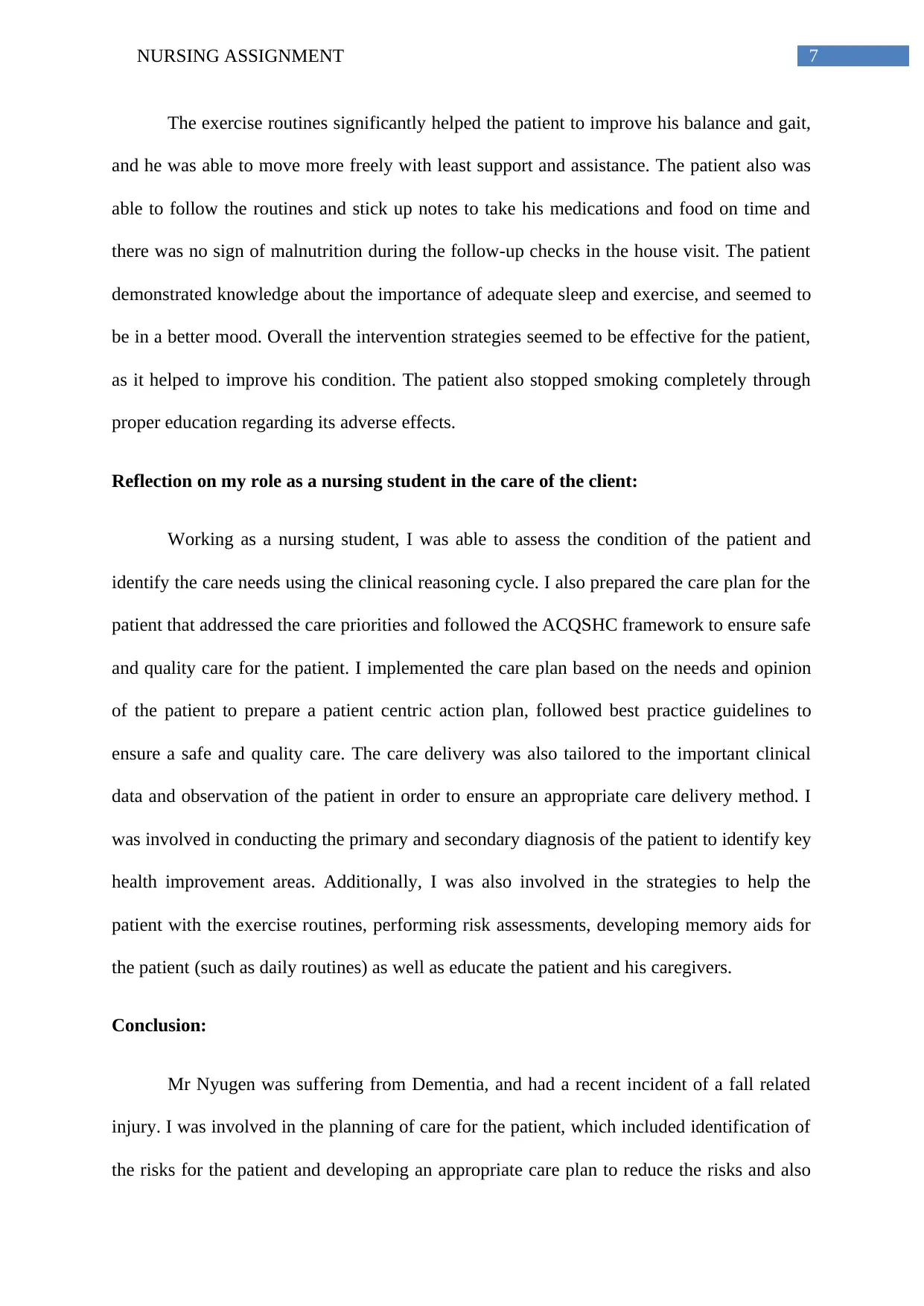
7NURSING ASSIGNMENT
The exercise routines significantly helped the patient to improve his balance and gait,
and he was able to move more freely with least support and assistance. The patient also was
able to follow the routines and stick up notes to take his medications and food on time and
there was no sign of malnutrition during the follow-up checks in the house visit. The patient
demonstrated knowledge about the importance of adequate sleep and exercise, and seemed to
be in a better mood. Overall the intervention strategies seemed to be effective for the patient,
as it helped to improve his condition. The patient also stopped smoking completely through
proper education regarding its adverse effects.
Reflection on my role as a nursing student in the care of the client:
Working as a nursing student, I was able to assess the condition of the patient and
identify the care needs using the clinical reasoning cycle. I also prepared the care plan for the
patient that addressed the care priorities and followed the ACQSHC framework to ensure safe
and quality care for the patient. I implemented the care plan based on the needs and opinion
of the patient to prepare a patient centric action plan, followed best practice guidelines to
ensure a safe and quality care. The care delivery was also tailored to the important clinical
data and observation of the patient in order to ensure an appropriate care delivery method. I
was involved in conducting the primary and secondary diagnosis of the patient to identify key
health improvement areas. Additionally, I was also involved in the strategies to help the
patient with the exercise routines, performing risk assessments, developing memory aids for
the patient (such as daily routines) as well as educate the patient and his caregivers.
Conclusion:
Mr Nyugen was suffering from Dementia, and had a recent incident of a fall related
injury. I was involved in the planning of care for the patient, which included identification of
the risks for the patient and developing an appropriate care plan to reduce the risks and also
The exercise routines significantly helped the patient to improve his balance and gait,
and he was able to move more freely with least support and assistance. The patient also was
able to follow the routines and stick up notes to take his medications and food on time and
there was no sign of malnutrition during the follow-up checks in the house visit. The patient
demonstrated knowledge about the importance of adequate sleep and exercise, and seemed to
be in a better mood. Overall the intervention strategies seemed to be effective for the patient,
as it helped to improve his condition. The patient also stopped smoking completely through
proper education regarding its adverse effects.
Reflection on my role as a nursing student in the care of the client:
Working as a nursing student, I was able to assess the condition of the patient and
identify the care needs using the clinical reasoning cycle. I also prepared the care plan for the
patient that addressed the care priorities and followed the ACQSHC framework to ensure safe
and quality care for the patient. I implemented the care plan based on the needs and opinion
of the patient to prepare a patient centric action plan, followed best practice guidelines to
ensure a safe and quality care. The care delivery was also tailored to the important clinical
data and observation of the patient in order to ensure an appropriate care delivery method. I
was involved in conducting the primary and secondary diagnosis of the patient to identify key
health improvement areas. Additionally, I was also involved in the strategies to help the
patient with the exercise routines, performing risk assessments, developing memory aids for
the patient (such as daily routines) as well as educate the patient and his caregivers.
Conclusion:
Mr Nyugen was suffering from Dementia, and had a recent incident of a fall related
injury. I was involved in the planning of care for the patient, which included identification of
the risks for the patient and developing an appropriate care plan to reduce the risks and also
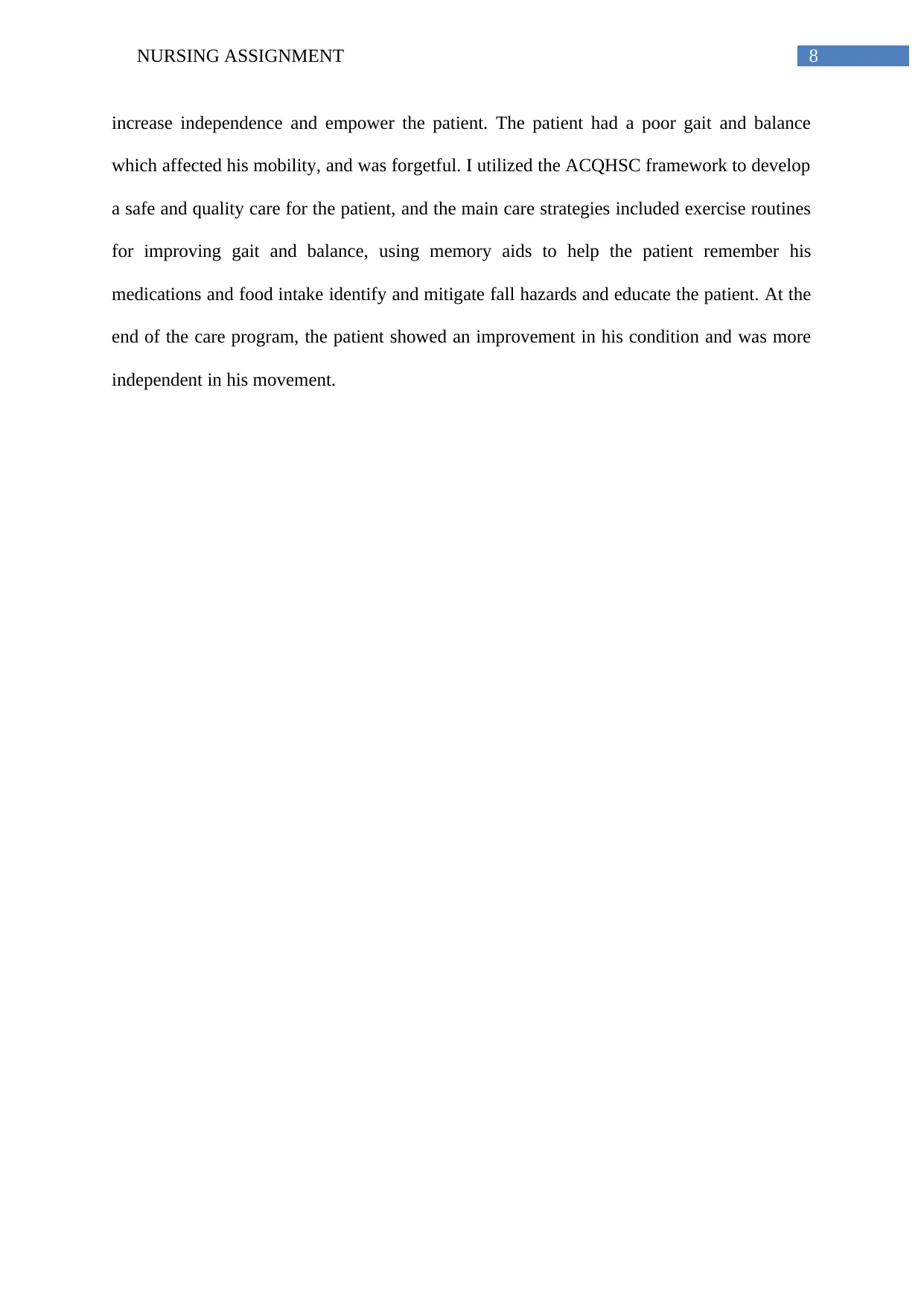
8NURSING ASSIGNMENT
increase independence and empower the patient. The patient had a poor gait and balance
which affected his mobility, and was forgetful. I utilized the ACQHSC framework to develop
a safe and quality care for the patient, and the main care strategies included exercise routines
for improving gait and balance, using memory aids to help the patient remember his
medications and food intake identify and mitigate fall hazards and educate the patient. At the
end of the care program, the patient showed an improvement in his condition and was more
independent in his movement.
increase independence and empower the patient. The patient had a poor gait and balance
which affected his mobility, and was forgetful. I utilized the ACQHSC framework to develop
a safe and quality care for the patient, and the main care strategies included exercise routines
for improving gait and balance, using memory aids to help the patient remember his
medications and food intake identify and mitigate fall hazards and educate the patient. At the
end of the care program, the patient showed an improvement in his condition and was more
independent in his movement.
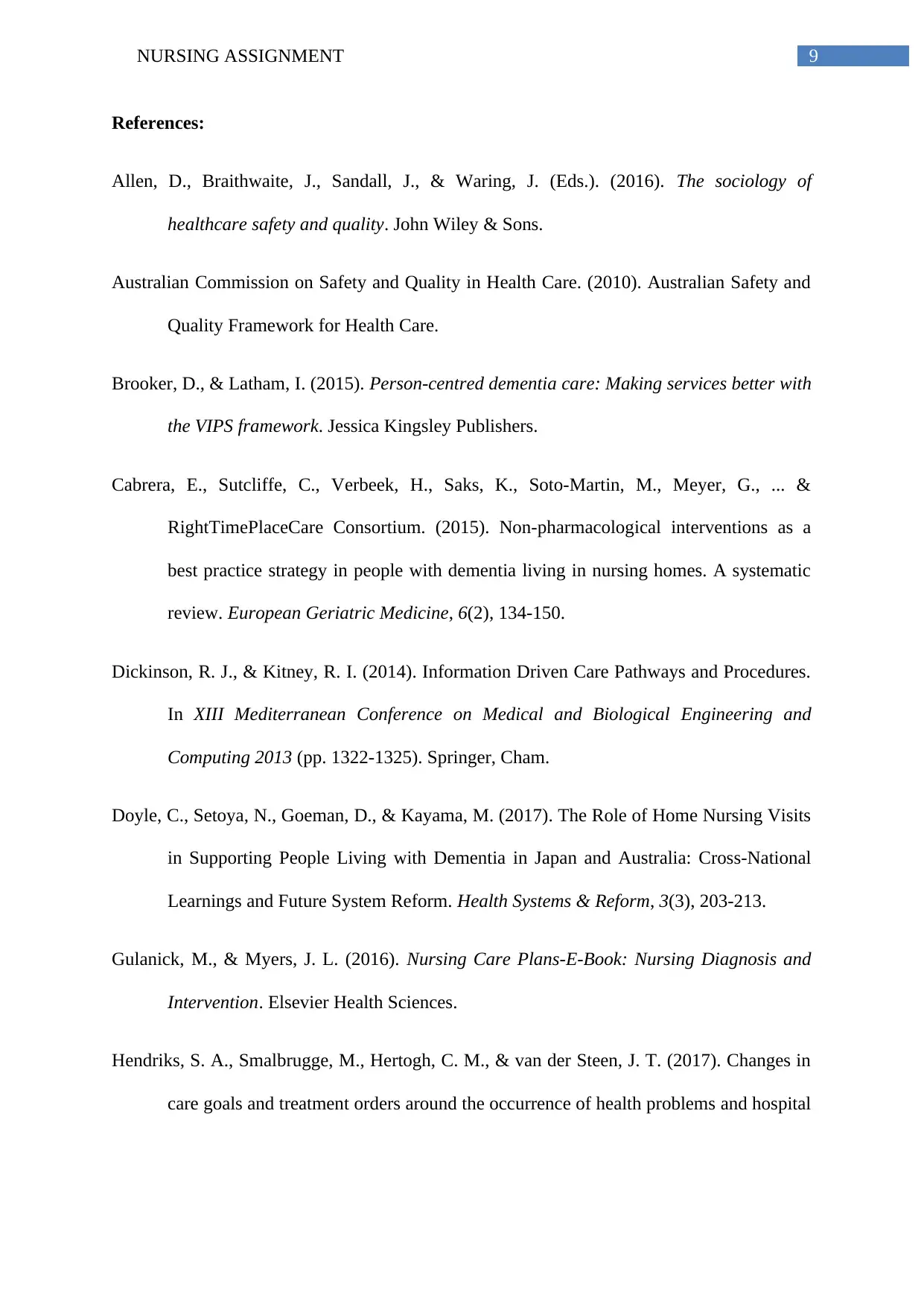
9NURSING ASSIGNMENT
References:
Allen, D., Braithwaite, J., Sandall, J., & Waring, J. (Eds.). (2016). The sociology of
healthcare safety and quality. John Wiley & Sons.
Australian Commission on Safety and Quality in Health Care. (2010). Australian Safety and
Quality Framework for Health Care.
Brooker, D., & Latham, I. (2015). Person-centred dementia care: Making services better with
the VIPS framework. Jessica Kingsley Publishers.
Cabrera, E., Sutcliffe, C., Verbeek, H., Saks, K., Soto-Martin, M., Meyer, G., ... &
RightTimePlaceCare Consortium. (2015). Non-pharmacological interventions as a
best practice strategy in people with dementia living in nursing homes. A systematic
review. European Geriatric Medicine, 6(2), 134-150.
Dickinson, R. J., & Kitney, R. I. (2014). Information Driven Care Pathways and Procedures.
In XIII Mediterranean Conference on Medical and Biological Engineering and
Computing 2013 (pp. 1322-1325). Springer, Cham.
Doyle, C., Setoya, N., Goeman, D., & Kayama, M. (2017). The Role of Home Nursing Visits
in Supporting People Living with Dementia in Japan and Australia: Cross-National
Learnings and Future System Reform. Health Systems & Reform, 3(3), 203-213.
Gulanick, M., & Myers, J. L. (2016). Nursing Care Plans-E-Book: Nursing Diagnosis and
Intervention. Elsevier Health Sciences.
Hendriks, S. A., Smalbrugge, M., Hertogh, C. M., & van der Steen, J. T. (2017). Changes in
care goals and treatment orders around the occurrence of health problems and hospital
References:
Allen, D., Braithwaite, J., Sandall, J., & Waring, J. (Eds.). (2016). The sociology of
healthcare safety and quality. John Wiley & Sons.
Australian Commission on Safety and Quality in Health Care. (2010). Australian Safety and
Quality Framework for Health Care.
Brooker, D., & Latham, I. (2015). Person-centred dementia care: Making services better with
the VIPS framework. Jessica Kingsley Publishers.
Cabrera, E., Sutcliffe, C., Verbeek, H., Saks, K., Soto-Martin, M., Meyer, G., ... &
RightTimePlaceCare Consortium. (2015). Non-pharmacological interventions as a
best practice strategy in people with dementia living in nursing homes. A systematic
review. European Geriatric Medicine, 6(2), 134-150.
Dickinson, R. J., & Kitney, R. I. (2014). Information Driven Care Pathways and Procedures.
In XIII Mediterranean Conference on Medical and Biological Engineering and
Computing 2013 (pp. 1322-1325). Springer, Cham.
Doyle, C., Setoya, N., Goeman, D., & Kayama, M. (2017). The Role of Home Nursing Visits
in Supporting People Living with Dementia in Japan and Australia: Cross-National
Learnings and Future System Reform. Health Systems & Reform, 3(3), 203-213.
Gulanick, M., & Myers, J. L. (2016). Nursing Care Plans-E-Book: Nursing Diagnosis and
Intervention. Elsevier Health Sciences.
Hendriks, S. A., Smalbrugge, M., Hertogh, C. M., & van der Steen, J. T. (2017). Changes in
care goals and treatment orders around the occurrence of health problems and hospital
Secure Best Marks with AI Grader
Need help grading? Try our AI Grader for instant feedback on your assignments.
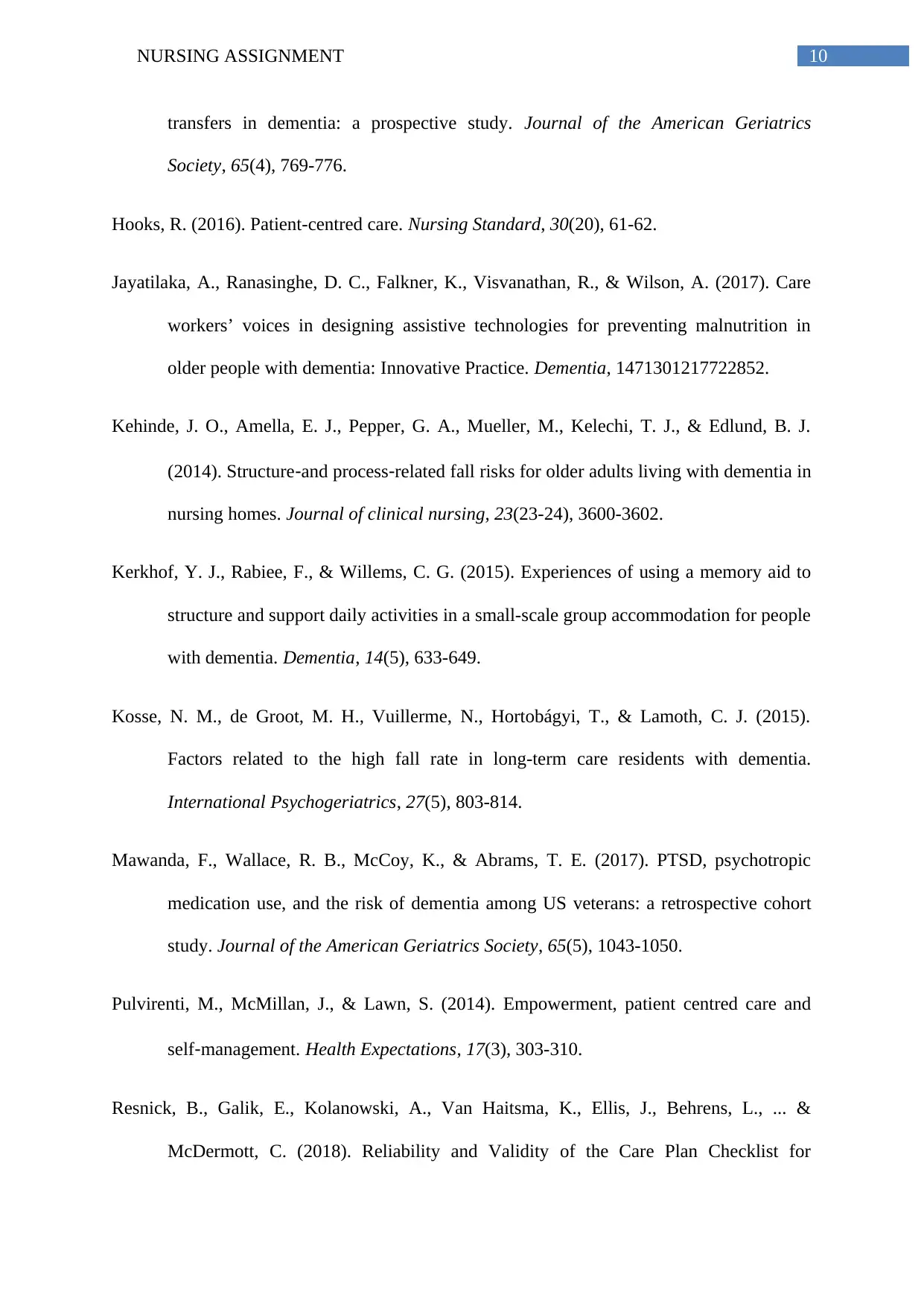
10NURSING ASSIGNMENT
transfers in dementia: a prospective study. Journal of the American Geriatrics
Society, 65(4), 769-776.
Hooks, R. (2016). Patient-centred care. Nursing Standard, 30(20), 61-62.
Jayatilaka, A., Ranasinghe, D. C., Falkner, K., Visvanathan, R., & Wilson, A. (2017). Care
workers’ voices in designing assistive technologies for preventing malnutrition in
older people with dementia: Innovative Practice. Dementia, 1471301217722852.
Kehinde, J. O., Amella, E. J., Pepper, G. A., Mueller, M., Kelechi, T. J., & Edlund, B. J.
(2014). Structure‐and process‐related fall risks for older adults living with dementia in
nursing homes. Journal of clinical nursing, 23(23-24), 3600-3602.
Kerkhof, Y. J., Rabiee, F., & Willems, C. G. (2015). Experiences of using a memory aid to
structure and support daily activities in a small-scale group accommodation for people
with dementia. Dementia, 14(5), 633-649.
Kosse, N. M., de Groot, M. H., Vuillerme, N., Hortobágyi, T., & Lamoth, C. J. (2015).
Factors related to the high fall rate in long-term care residents with dementia.
International Psychogeriatrics, 27(5), 803-814.
Mawanda, F., Wallace, R. B., McCoy, K., & Abrams, T. E. (2017). PTSD, psychotropic
medication use, and the risk of dementia among US veterans: a retrospective cohort
study. Journal of the American Geriatrics Society, 65(5), 1043-1050.
Pulvirenti, M., McMillan, J., & Lawn, S. (2014). Empowerment, patient centred care and
self‐management. Health Expectations, 17(3), 303-310.
Resnick, B., Galik, E., Kolanowski, A., Van Haitsma, K., Ellis, J., Behrens, L., ... &
McDermott, C. (2018). Reliability and Validity of the Care Plan Checklist for
transfers in dementia: a prospective study. Journal of the American Geriatrics
Society, 65(4), 769-776.
Hooks, R. (2016). Patient-centred care. Nursing Standard, 30(20), 61-62.
Jayatilaka, A., Ranasinghe, D. C., Falkner, K., Visvanathan, R., & Wilson, A. (2017). Care
workers’ voices in designing assistive technologies for preventing malnutrition in
older people with dementia: Innovative Practice. Dementia, 1471301217722852.
Kehinde, J. O., Amella, E. J., Pepper, G. A., Mueller, M., Kelechi, T. J., & Edlund, B. J.
(2014). Structure‐and process‐related fall risks for older adults living with dementia in
nursing homes. Journal of clinical nursing, 23(23-24), 3600-3602.
Kerkhof, Y. J., Rabiee, F., & Willems, C. G. (2015). Experiences of using a memory aid to
structure and support daily activities in a small-scale group accommodation for people
with dementia. Dementia, 14(5), 633-649.
Kosse, N. M., de Groot, M. H., Vuillerme, N., Hortobágyi, T., & Lamoth, C. J. (2015).
Factors related to the high fall rate in long-term care residents with dementia.
International Psychogeriatrics, 27(5), 803-814.
Mawanda, F., Wallace, R. B., McCoy, K., & Abrams, T. E. (2017). PTSD, psychotropic
medication use, and the risk of dementia among US veterans: a retrospective cohort
study. Journal of the American Geriatrics Society, 65(5), 1043-1050.
Pulvirenti, M., McMillan, J., & Lawn, S. (2014). Empowerment, patient centred care and
self‐management. Health Expectations, 17(3), 303-310.
Resnick, B., Galik, E., Kolanowski, A., Van Haitsma, K., Ellis, J., Behrens, L., ... &
McDermott, C. (2018). Reliability and Validity of the Care Plan Checklist for

11NURSING ASSIGNMENT
Evidence of Person-Centered Approaches for Behavioral and Psychological
Symptoms Associated With Dementia. Journal of the American Medical Directors
Association, 19(7), 613-618.
Romli, M. H., Mackenzie, L., Lovarini, M., Tan, M. P., & Clemson, L. (2018). The
clinimetric properties of instruments measuring home hazards for older people at risk
of falling: a systematic review. Evaluation & the health professions, 41(1), 82-128.
Tannenbaum, C., Martin, P., Tamblyn, R., Benedetti, A., & Ahmed, S. (2014). Reduction of
inappropriate benzodiazepine prescriptions among older adults through direct patient
education: the EMPOWER cluster randomized trial. JAMA internal medicine, 174(6),
890-898.
Toots, A., Littbrand, H., Holmberg, H., Nordström, P., Lundin-Olsson, L., Gustafson, Y., &
Rosendahl, E. (2017). Walking aids moderate exercise effects on gait speed in people
with dementia: A randomized controlled trial. Journal of the American Medical
Directors Association, 18(3), 227-233.
Zhong, G., Wang, Y., Zhang, Y., Guo, J. J., & Zhao, Y. (2015). Smoking is associated with
an increased risk of dementia: a meta-analysis of prospective cohort studies with
investigation of potential effect modifiers. PloS one, 10(3), e0118333.
Evidence of Person-Centered Approaches for Behavioral and Psychological
Symptoms Associated With Dementia. Journal of the American Medical Directors
Association, 19(7), 613-618.
Romli, M. H., Mackenzie, L., Lovarini, M., Tan, M. P., & Clemson, L. (2018). The
clinimetric properties of instruments measuring home hazards for older people at risk
of falling: a systematic review. Evaluation & the health professions, 41(1), 82-128.
Tannenbaum, C., Martin, P., Tamblyn, R., Benedetti, A., & Ahmed, S. (2014). Reduction of
inappropriate benzodiazepine prescriptions among older adults through direct patient
education: the EMPOWER cluster randomized trial. JAMA internal medicine, 174(6),
890-898.
Toots, A., Littbrand, H., Holmberg, H., Nordström, P., Lundin-Olsson, L., Gustafson, Y., &
Rosendahl, E. (2017). Walking aids moderate exercise effects on gait speed in people
with dementia: A randomized controlled trial. Journal of the American Medical
Directors Association, 18(3), 227-233.
Zhong, G., Wang, Y., Zhang, Y., Guo, J. J., & Zhao, Y. (2015). Smoking is associated with
an increased risk of dementia: a meta-analysis of prospective cohort studies with
investigation of potential effect modifiers. PloS one, 10(3), e0118333.
1 out of 12
Related Documents
Your All-in-One AI-Powered Toolkit for Academic Success.
+13062052269
info@desklib.com
Available 24*7 on WhatsApp / Email
![[object Object]](/_next/static/media/star-bottom.7253800d.svg)
Unlock your academic potential
© 2024 | Zucol Services PVT LTD | All rights reserved.





